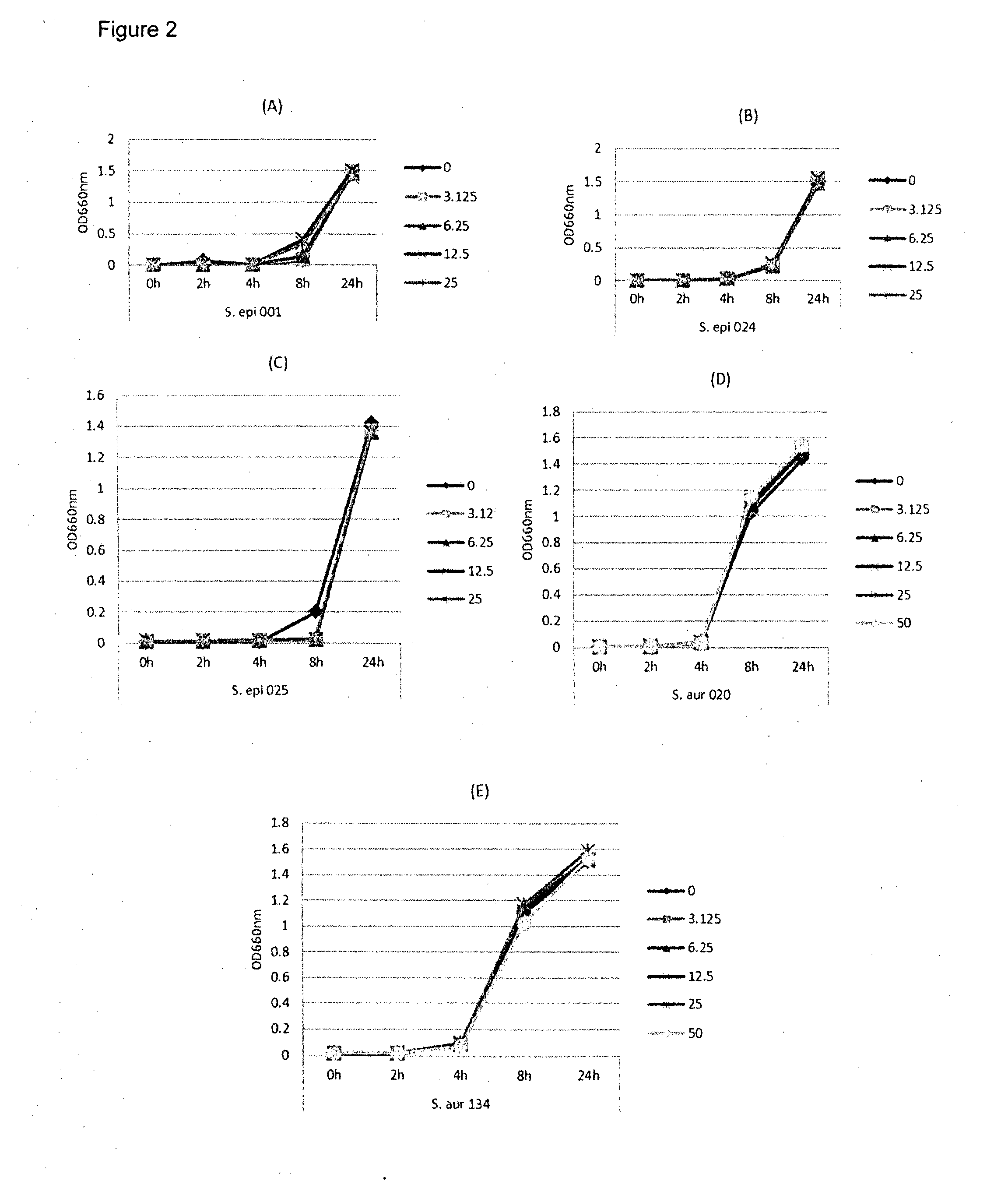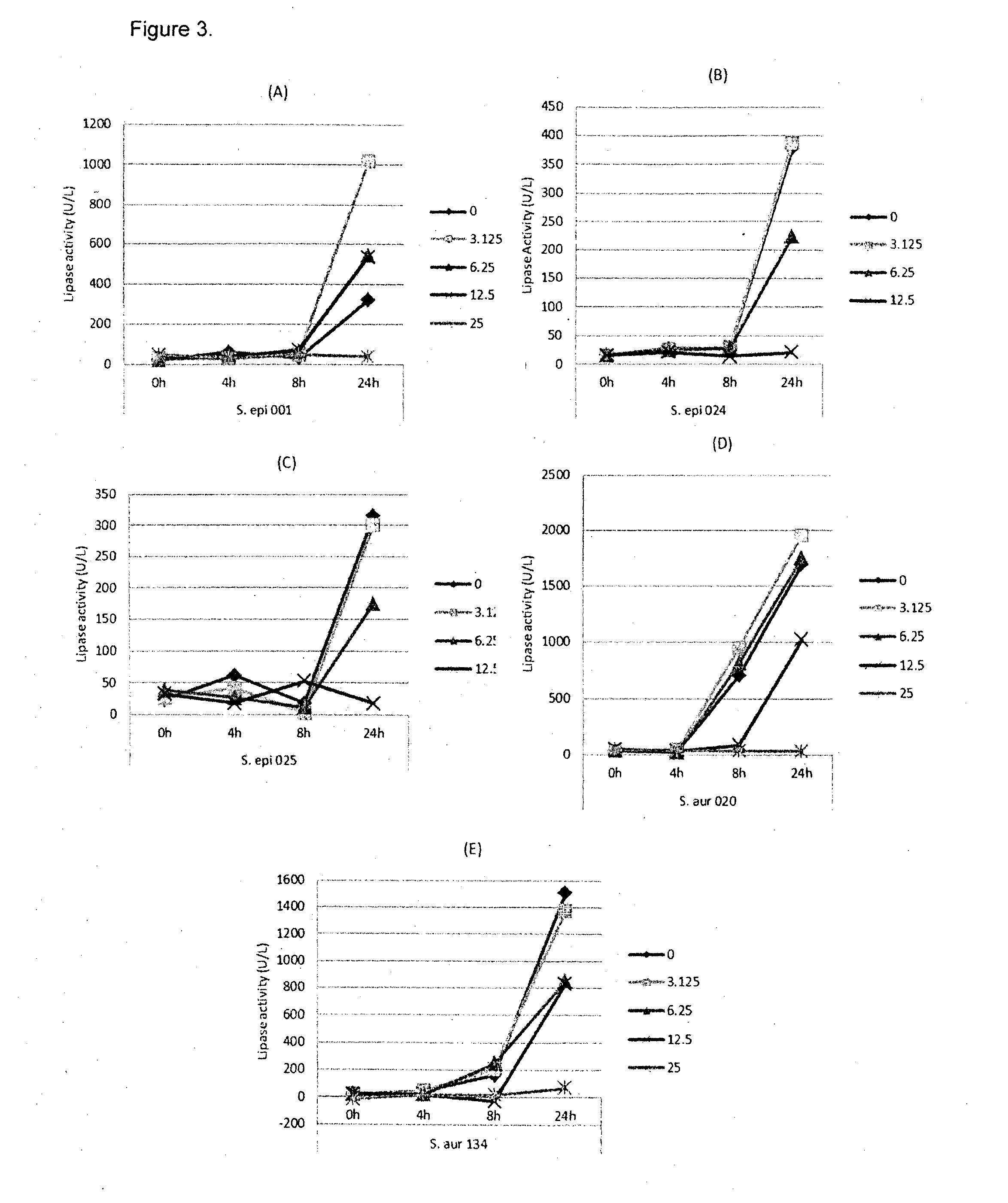Compositions, Methods and/or Devices For Prevention and/or Treatment Of Dry Eye Disorders
a technology for dry eye and compositions, applied in the direction of drug compositions, peptides, cardiovascular disorders, etc., can solve the problems of affecting tear film stability, affecting tear film evaporation, and not being able to cure, so as to improve tear film stability, and improve tear film stability
- Summary
- Abstract
- Description
- Claims
- Application Information
AI Technical Summary
Benefits of technology
Problems solved by technology
Method used
Image
Examples
example 1
[0107]One aspect of this invention is inhibition of lipase activity without substantial antibacterial activity. This example illustrates one readily available assay for lipase activity and bacterial growth in certain conditions; especially concentration of active, time and bacterial species. In the following example, lipase activity and bacterial growth has been assayed in four different strains of bacteria following treatment with various concentrations of glycerol monolaurate or lauric acid.
[0108]The bacterial strains S. aureus 020 & 134, and S. epidermidis 024 & 025 were grown at 37° C. in TSB treated with 0, 6.25 or 12.5 μg / ml of glycerol monolaurate or lauric acid as well as in TSB extraction of glycerol monolaurate ointment prior to assay of bacterial growth and lipase activity. After incubation for 24 h, bacterial growth was determined by measuring the optical density of cultures using a spectrophotometer at a wavelength of 660 nm. Lipase activity by test bacterial strains un...
example 2
[0109]In this example, lipase and bacterial activity has been similarly assayed in five different strains of bacteria (S. epi001, S.epi024, S.epi025, S.aur020 and S.aur134). The bacterial strains were treated with 0, 3.125, 6.25, 12.5 or 25 μg / ml of glycerol monolaurate or lauric acid and grown in TSB at 37° C. After incubation for 24 h, both bacterial growth and lipase production were determined. FIG. 1 shows the results of the bacterial growth assay for the strains treated with glycerol monolaurate. FIG. 2 the results of the bacterial growth assay for the strains treated with lauric acid. FIG. 3 shows the results of the lipase production assay for the strains treated with glycerol monolaurate. FIG. 4 shows the results of the lipase production assay for the strains treated with lauric acid. FIG. 5 shows the percentage reduction of lipase production for each test strain and treatment.
example 3
[0110]The following tables provide several examples of compositions, according to certain embodiments. The compositions contain either glycerol monolaurate and / or caprylic acid and / or lauric acid and / or monocaprin with or without androgen, with or without an anti-inflammatory agent, buffer (NaOH / HCl) and a tonicity agent (sodium chloride). Compositions 1, 2 and 4 to 7 contain a preservative (chlorobutanol although benzalkonium chloride or alkyldimethylbenzylammonium chloride could also be used). Composition 3 and 8 is a preservative free preparation containing glycerol monolaurate and composition 9 is a preservative free preparation containing lauric acid. Composition 10 is a preservative free preparation containing glycerol monolaurate and androgen and composition 11 is a preservative free preparation containing lauric acid and androgen. Composition 12 is a preservative free preparation containing glycerol monolaurate and androgen and an anti-inflammatory agent. Composition 13 is a...
PUM
| Property | Measurement | Unit |
|---|---|---|
| concentration | aaaaa | aaaaa |
| concentration | aaaaa | aaaaa |
| concentration | aaaaa | aaaaa |
Abstract
Description
Claims
Application Information
 Login to View More
Login to View More - R&D
- Intellectual Property
- Life Sciences
- Materials
- Tech Scout
- Unparalleled Data Quality
- Higher Quality Content
- 60% Fewer Hallucinations
Browse by: Latest US Patents, China's latest patents, Technical Efficacy Thesaurus, Application Domain, Technology Topic, Popular Technical Reports.
© 2025 PatSnap. All rights reserved.Legal|Privacy policy|Modern Slavery Act Transparency Statement|Sitemap|About US| Contact US: help@patsnap.com



